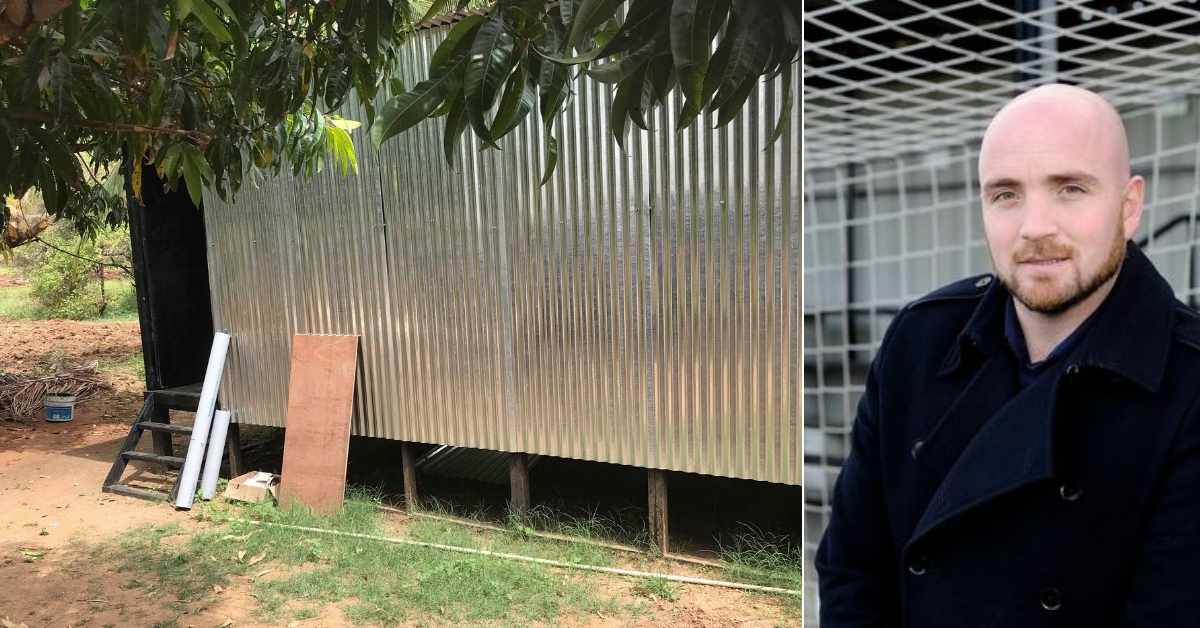Hailing from the port city of Hull in East Yorkshire, 37-year-old Jamie Waltham made his first trip to India in 2018. It lasted for four months.
He had one aim–to build a sustainable home in a small space; a home that could be built in a short period from locally-available materials and be powered by the sun.
The result was a beautiful, low-cost, eco-friendly home built on a 220 sq ft plot, on a farm in Honennahalli in Karnataka’s Tumakuru District, about a three-hour drive from Bengaluru.

Speaking to The Better India, Jamie says, “To be honest, I wanted to come to India for a few years. Once the timing felt right, I just landed here with absolutely no plans or contacts, only to find a site and then build a sustainable home.”
He came to the maximum city and looked for a site for over six weeks until he met Uzair Ahmed.
A Karnataka-based entrepreneur, Uzair Ahmed was at the same hostel as Jamie. When the Briton discussed his plans to find a location for the project, Uzair told him about a potential place in Bengaluru where he could set up this low-cost home.
This was a plot in Sira and belonged to Uzair’s family. And that’s how Jamie kickstarted the project in June 2018.
The home
Built in less than two months, Jamie funded the project costing Rs 1.5 lakh from his own pocket. He worked relentlessly and only sought external help for the transportation of materials needed to set up the house.
This home, which consisted of six beds, electricity, water, and toilet facilities, was given to a family working on one part of the farm. Jamie refers to them as Ramesh, Rekha, Mamma and Papa.
He says, “They lived in a very basic room. I really wanted to provide them with facilities like the others who worked on a different part of the farm did. They were really happy with it.”
The 220 sq ft home is equipped with solar panels for its energy needs, a sewage managing unit, and condensation coils that tap water from the air to meet household needs.
While he used galvanised steel for the walls, timber was used for pillars and plywood for partitions for the home.
Jamie adds how one of the challenges was procuring the materials. Whether it was solar panels, the inverter or wood, he needed to make several trips between Sira and Bengaluru, across small stores and big yards.
Jamie is associated with a non-profit, United Foundation, which regularly takes up similar projects. But the sustainable home in Bengaluru was conceptualised and executed single-handedly by him.
In a video, he explains how the home is also equipped with an above-the-ground septic tank, collecting sludge from the toilet. This can either be discharged into the ground using a PVC pipe or be collected in a tub covered with a lid, using the tank’s valve.
The collected sludge can either be disposed of by the residents using the detachable tub or be left to dry. After the heat from the sun kills the germs in the sludge, this dried waste can be used as a natural fertiliser at the farm.
Once completed, as a sign of gratitude, Jamie named the home after the eldest member of Uzair’s family – Zahir – before handing it over to Ramesh’s family.
Jamie has built a model that could be replicated to make housing economically viable to those who require it the most, while also ensuring the process of building and maintaining it did not pose threats to the environment.
Also Read: This Bengaluru Engineer’s Green, Innovative & Low-Cost Home Is Perfect for Us All
I ask Jamie about any plans to scale up such projects in other parts of the country.
He answers, “I am back in the UK now, and it is difficult for me to fund regular trips at the moment. My children are young and four months is a long time to stay away from them. But my plan is to gather volunteers and return to India in May. We are raising funds to build a full bamboo village, in collaboration with an organisation that owns land in some rural areas.”
We wish him the very best!
To know more, get in touch with Jamie on Facebook here.
(Edited by Shruti Singhal)
Like this story? Or have something to share?
Write to us: contact@thebetterindia.com
Connect with us on Facebook and Twitter.
If you found our stories insightful, informative, or even just enjoyable, we invite you to consider making a voluntary payment to support the work we do at The Better India. Your contribution helps us continue producing quality content that educates, inspires, and drives positive change.
Choose one of the payment options below for your contribution-
By paying for the stories you value, you directly contribute to sustaining our efforts focused on making a difference in the world. Together, let's ensure that impactful stories continue to be told and shared, enriching lives and communities alike.
Thank you for your support. Here are some frequently asked questions you might find helpful to know why you are contributing?
